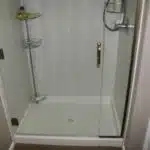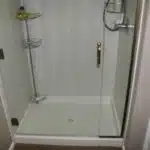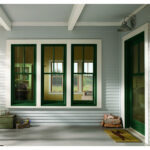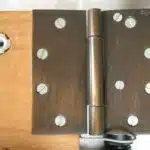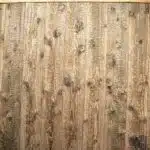As a door repair specialist, fixing holes in doors is a common task that I come across. Whether it’s caused by accidental bumps or wear and tear over time, a hole in a door can be unsightly and compromise security. Fortunately, repairing a hole in a door is not as daunting as it may seem. With the right tools and techniques, anyone can fix a hole in their door and restore its structural integrity.
In this article, we will explore the steps involved in fixing a hole in a door. We will begin by discussing the materials needed for the job, including necessary safety equipment. Next, we will walk you through the process of preparing your work area and assessing the damage to determine the appropriate repair method. Finally, we will provide step-by-step instructions on how to execute the repair itself and offer tips to ensure your door remains strong and functional for years to come. By following these guidelines, you can save money on costly replacements and take pride in knowing you’ve tackled this DIY project like a pro.
Safety Precautions Before You Begin
As a door repair specialist, I understand that fixing a hole in a door can be a daunting task. However, with the right safety precautions and tools, it is possible to complete the job safely and effectively. Before you begin any repairs, it is crucial to explore safety precautions in detail.
Exploring safety means understanding the risks involved with repairing doors. One potential hazard is breathing in toxic fumes from certain chemicals used during repairs. Another risk is physical injury from handling sharp tools or inhaling dust particles. Therefore, it’s important to wear protective gear such as gloves and goggles while working on the door.
Safety precautions details are essential for preventing accidents and injuries during repairs. For instance, make sure the work area is well-lit and free of clutter to avoid tripping hazards. Also, ensure that electrical sources are turned off before beginning any repairs involving power tools. By taking these necessary precautions, you can ensure that you complete your project safely and without incident.
With safety as our top priority, our next step will be gathering the necessary tools and materials for fixing a hole in a door.
Gathering The Necessary Tools And Materials
To begin fixing a hole in a door, it is important to gather the necessary tools and materials. Depending on the size and location of the hole, you may need different items. For smaller holes, a putty knife, spackle or wood filler, sandpaper, and paint may suffice. However, for larger holes or damage to the door frame, additional tools such as a saw or drill may be required.
Before attempting any repairs yourself, it is important to consider whether DIY repair is appropriate or if professional assistance is needed. While DIY repair can be budget-friendly, it may not always result in a long-lasting solution. A professional repair will likely cost more but provide better quality and durability in the long term. Additionally, some repairs may require specialized skills and equipment that only professionals possess.
When gathering materials for your door repair project, keep in mind that there are many budget-friendly options available. Brands such as Elmer’s and DAP offer affordable spackle and wood fillers that work just as well as their pricier counterparts. It is also possible to find discounted paint at home improvement stores by looking for discontinued colors or purchasing mistinted cans. By taking advantage of these options, you can save money while still achieving great results.
To assess the damage before beginning your repairs, thoroughly examine the area around the hole to determine if there are any underlying issues that need to be addressed first. This includes checking for rotting wood or moisture damage which could compromise the structural integrity of the door. Once any underlying issues have been addressed, you can move on to assessing the size and shape of the hole itself to determine what materials will be needed for an effective repair solution.
Assessing The Damage
As you gather the necessary tools and materials to fix a hole in your door, it’s important to assess the damage before determining the best course of action. This step is crucial as it will allow you to evaluate your options and determine the severity of the damage. By doing so, you’ll be able to choose the right repair method that will help restore your door’s integrity.
To assess the damage, start by examining the size and location of the hole. If it’s a small hole located near the edge or corner of the door, then you can use wood filler or putty to patch it up. However, if it’s a larger hole located in the middle of your door or has caused significant damage to its structure, then you may need to replace a section or even the entire door.
Another factor to consider when assessing damage is whether there are any underlying issues that caused the hole in your door in the first place. For example, if there was water damage or termite infestation, this could indicate more significant problems that need addressing before repairs can begin. By taking these factors into account when assessing damage, you’ll be able to make informed decisions about how best to fix your door.
Moving forward with assessing damage is an important step towards fixing a hole in your door. It allows you to evaluate different options and determine which repair method would work best for your situation. Next up, we’ll discuss choosing the right repair method so that you can get started on restoring your damaged door!
Choosing The Right Repair Method
When it comes to fixing a hole in a door, choosing the right repair method is crucial. There are several options available, each with its own pros and cons. It’s important to consider factors such as the size of the hole, the type of door, and your budget before deciding which method to use.
One option for repairing a hole in a door is to use wood filler. This method involves filling the hole with a putty-like substance that hardens over time. The advantage of using wood filler is that it’s relatively inexpensive and easy to use. However, it’s not always the most durable option, particularly for larger holes or doors that are frequently used.
Another option is to replace the damaged section of the door with a patch. This method involves cutting out the damaged area and replacing it with a new piece of wood or other material. The advantage of this approach is that it can be very durable and can result in a seamless repair. However, it can also be more expensive and time-consuming than some other methods.
When deciding which method to use for repairing a hole in a door, it’s important to compare the pros and cons of each option as well as their cost. Consider factors such as durability, ease of use, and overall appearance when making your decision. Ultimately, choosing the right repair method will depend on your specific needs and preferences.
Moving forward from here, filling small holes with wood filler is another effective way to repair damage to doors. By using this approach, you can fill in small dents or scratches without having to replace any part of the door itself.
Filling Small Holes With Wood Filler
After determining the appropriate repair method for your door, it is important to consider whether you will be staining or painting the repaired area. If you are planning on staining the door, it is crucial to choose a wood filler that matches the wood grain and color of your door. On the other hand, if you plan on painting the door, any type of wood filler can be used.
There are different types of wood fillers available in the market, each with its own set of pros and cons. For small holes, water-based wood fillers work well as they are easy to apply and can be sanded down once dry. However, for larger holes or areas with heavy damage, epoxy-based fillers may be required as they provide added strength and durability.
When using wood filler, it is important to follow manufacturer instructions carefully to ensure a successful repair. Make sure to clean and sand the damaged area before applying the filler. Once applied, allow sufficient time for drying before sanding down any excess material. Remember that proper preparation and application of wood filler is key to achieving a seamless repair that blends in with the rest of your door’s surface.
Moving forward from filling small holes with wood filler, another technique that can be used for repairing medium-sized holes is using a dutchman patch. This involves cutting out a piece of matching wood grain from an inconspicuous area of your door and fitting it into the damaged area like a puzzle piece. This method requires more skill than filling small holes with wood filler but results in a more natural-looking repair that maintains the structural integrity of your door.
Repairing Medium-Sized Holes With A Dutchman Patch
Medium-sized holes in doors can be fixed by using different patching techniques. One of the most effective methods is to use a Dutchman patch. This technique involves cutting out the damaged area and replacing it with a new piece of wood.
Before starting the repair process, it is important to sand down the edges of the hole to ensure a smooth surface for the patch to adhere to. After cutting out the damaged area, measure and cut a new piece of wood that fits snugly into the hole. Apply wood glue around the edges of the hole and press the new piece into place.
Once the glue has dried, sand down any rough edges and finish by painting or staining to match the existing door. It is important to note that sanding and finishing tips can vary depending on your specific door material. Taking these steps will create a seamless repair that restores both function and appearance to your door. Next, we will discuss how to cut and install a Dutchman patch in more detail.
Cutting And Installing A Dutchman Patch
After repairing medium-sized holes with a Dutchman patch, it is time to cut and install the patch. Cutting techniques can vary depending on the size of the hole, but one commonly used method is tracing an outline of the patch onto the door using a pencil or marker. Then, using a jigsaw or handsaw, carefully cut along the traced lines. After cutting out the damaged area, sand down any rough edges to ensure a smooth surface for the Dutchman patch.
Once you have cut out the damaged area, it’s time to secure the patch. Apply wood glue to both sides of the Dutchman patch and insert it into the hole, ensuring that it fits snugly. Use clamps to hold it in place until the glue dries completely. Once dry, use sandpaper to smooth out any rough spots around the edges of the patch and apply wood filler as needed to achieve a seamless finish.
To summarize:
- Cutting techniques can vary depending on hole size
- Sand down rough edges after cutting
- Secure Dutchman patch with wood glue and clamps before smoothing out any rough spots with sandpaper
Next up: Using a Bondo Patch for Large Holes – Using a Bondo patch is a great option for repairing larger holes as it provides a strong and durable finish.
Using A Bondo Patch For Large Holes
A Bondo patch is a great solution for fixing large holes in doors. One of the significant benefits of Bondo is its strength and durability once it sets. It creates a hard surface that can withstand impact and even resist moisture, making it an ideal solution for door repair.
Alternative repair methods, such as using wood filler or spackle, may work for smaller holes, but they are not as effective for larger ones. These materials tend to shrink and crack over time, leaving the repaired area vulnerable to further damage. Bondo, on the other hand, fills the hole completely and bonds tightly to the surrounding material.
To use Bondo to fix a hole in a door, you’ll need to follow a few simple steps. The first step is prepping the surface for Bondo application. This involves removing any loose debris or old patching material from the hole and sanding down the edges of the hole until they’re smooth. Once you’ve prepped the surface, you can begin applying Bondo.
Prepping The Surface For Bondo
- Sanding the surface of the door is the first step in prepping the surface for Bondo to ensure a smooth, even finish.
- Priming the door is important to ensure the Bondo adheres to the surface and also provides a consistent base for the application of the Bondo.
- Filling any gaps or cracks should be done with an appropriate filler before applying Bondo, as the Bondo will not fill these gaps and can lead to further issues.
- Sanding should be done using a fine grit sandpaper, taking care to remove any paint, rust, or other debris from the surface.
- Priming should be done with a paint appropriate for the surface of the door and should be done in multiple coats for best results.
- Filling any gaps or cracks should be done with a fast-drying filler that is appropriate for the surface of the door.
Sanding
Sanding is a crucial step in prepping the surface for Bondo. It involves removing any roughness, bumps or protrusions on the surface of the door. This step ensures that the Bondo will adhere to a smooth and even surface. There are different sanding techniques that can be used depending on the severity of the damage.
One technique is using sandpaper with different grits to achieve a smooth finish. Starting with a coarse grit to remove any large bumps and gradually moving to finer grits until it reaches a smooth surface. Another technique is using an electric sander which makes sanding more efficient and faster. However, it should be used with caution as it can remove too much material if not handled properly.
It’s important to use the right tools when sanding like sandpaper, electric sander or sanding block. Sandpaper comes in different grits ranging from coarse to fine, so make sure you choose the right one for your project. An electric sander saves time, but if you’re working on small areas, using a sanding block would be more appropriate. Always remember to wear protective gear like goggles and gloves when working with power tools or chemicals like Bondo as they can be harmful to your health.
Priming
After sanding, the next crucial step in prepping the surface for Bondo is priming. Priming provides a layer of protection against moisture and corrosion, and it helps the Bondo adhere better to the surface. There are different types of primers available, each with its own benefits.
One type of primer is an etching primer which is used on bare metal surfaces. It contains acid that creates microscopic grooves on the surface, allowing the primer to adhere better. Another type is a high-build primer which fills in any small imperfections on the surface and creates a smooth base for painting. The benefits of priming include enhancing the lifespan of your repair work and providing a better finish.
When choosing a primer, it’s important to consider factors such as compatibility with your Bondo product and the type of surface you’re working on. It’s also essential to follow manufacturer instructions carefully when applying primers to ensure optimal results. By taking these steps, you can improve your chances of achieving a flawless repair job that will last for years to come.
Filling Gaps
In prepping a surface for Bondo, filling gaps is a crucial step. There are different types of gaps that you may encounter during the repair process. These include small pinholes, larger dents or cracks, and gaps between panels. Each type requires a different technique to fill effectively.
For small pinholes, you can use spot glazing putty to fill them in. This type of putty is easy to apply and dries quickly. For larger dents or cracks, you can use a mixture of Bondo body filler and hardener. This mixture can be applied to the damaged area and sanded down once it dries. Finally, for gaps between panels, you may need to use fiberglass cloth with Bondo resin to create a strong bond between the two surfaces.
When filling gaps, it’s important to follow manufacturer instructions carefully to ensure optimal results. You should also choose the right technique based on the type of gap you’re filling. By taking these steps and using the appropriate tools and materials, you can ensure that your repair work is flawless and long-lasting.
Applying The Bondo Patch
After prepping the surface for Bondo, it’s time to apply the patch. Some may think that Bondo is the only option for repairing a hole in a door, but there are other alternatives. However, Bondo is a popular choice because it is easy to use and dries quickly.
Applying techniques for Bondo vary depending on the size of the hole. For smaller holes, start by mixing a small amount of Bondo with the hardener. Apply it to the hole using a putty knife and smooth out any excess with sandpaper once it has dried. For larger holes, layer the Bondo over fiberglass mesh until it is level with the surface of the door.
If you prefer not to use Bondo, wood filler or epoxy can be used as alternatives. These require more time and effort as they may take longer to dry and may need multiple applications. Whichever method you choose, make sure to follow manufacturer instructions carefully and allow sufficient drying time before sanding and finishing the patch.
Sanding And Finishing The Patch
After the patch has dried completely, it’s time to sand down any unevenness. Use a coarse-grit sandpaper (60-80 grit) to start with and smooth out the surface of the patch until it’s flush with the rest of the door. Make sure to wear a mask and safety goggles during this process, as sanding can create a lot of dust.
Once you’ve achieved a smooth surface, switch to a finer grit sandpaper (120-220 grit) to further refine the finish. Be sure to use long, even strokes in the direction of the grain to prevent scratches or marks on the door. After finishing up with your preferred sandpaper grits, use a damp cloth or vacuum cleaner to clean up any remaining dust from your work area.
Finishing techniques for patching holes in doors can vary depending on personal preference or existing finishes on surrounding surfaces. For unfinished wood doors, seal the wood with primer before painting or staining. For finished doors, match paint or stain color using an inconspicuous area as reference. Apply two coats of paint or stain for complete coverage and let dry according to manufacturer instructions before rehanging your newly repaired door.
Painting Or Staining The Door
After sanding and finishing the patch, the next step is to decide whether to stain or paint the door. Staining allows the natural beauty of wood to shine through while creating a protective layer that prevents moisture from seeping in. On the other hand, painting gives you more color options and can add a pop of personality to your door. Both options have their advantages, so it ultimately comes down to personal preference.
Choosing the color for your door can be a fun but daunting task. When selecting a stain or paint color, consider the overall aesthetic of your home’s exterior. A neutral color like beige or gray can complement any style of house, while a bold hue like red or blue can make a statement. It’s also important to choose a color that complements your landscaping and any other outdoor decor.
Once you’ve made your decision on staining versus painting and chosen the color for your door, it’s important to maintain it properly. Regular cleaning with soap and water and avoiding harsh chemicals will keep your door looking like new for years to come. If you’ve opted for stain, reapplication may be necessary every few years depending on weather conditions. For painted doors, touch up any scuffs or scratches as they occur to prevent rusting or further damage. With proper maintenance, your repaired door will continue to enhance the beauty of your home for many years.
Maintaining Your Repaired Door
To maintain the integrity of your repaired door, it’s important to take preventative measures to avoid further damage. One tip is to regularly inspect your door for any signs of wear and tear, such as cracks or chipped paint. If you notice any issues, address them promptly before they worsen.
Another way to maintain your door is by following a recommended maintenance schedule. This can include cleaning and lubricating hinges, tightening screws and bolts, and applying protective coatings to prevent moisture damage. By keeping up with these tasks, you can prolong the life of your door and prevent future repairs.
Overall, taking care of your repaired door requires diligence and attention to detail. By implementing preventative measures and following a maintenance schedule, you can ensure that your door remains in good condition for years to come. However, if you encounter any issues that are beyond your expertise or ability to fix, it may be time to call in a professional for assistance with more complex repairs or replacements.
When To Call A Professional
When to Call a Professional:
While fixing minor damages in your door can be easily done by yourself, there are times when you should consider calling a professional. Door repair specialists have the knowledge and tools to handle major damages that may require complex repairs. Attempting to fix these issues on your own may lead to further damage and ultimately cost more money in the long run.
DIY alternatives for fixing a door hole may seem like a good idea at first, but without proper skills or experience, you may end up causing more harm than good. A professional will be able to assess the extent of the damage and provide an appropriate solution that is tailored to your specific needs. This will ensure that your door is repaired safely and efficiently, giving you peace of mind knowing that it is secure.
When deciding whether to fix a damaged door yourself or call a professional, consider the potential risks involved. A DIY repair job can lead to injury or cause additional damage to your property if not done correctly. By hiring a professional, you can avoid these risks and trust that your repair needs are being taken care of by someone who knows what they’re doing.
- Hiring a professional:
- Provides peace of mind
- Ensures safety
- DIY alternatives:
- May result in further damage
- Can lead to injury
Next, we’ll answer some frequently asked questions about door repair.
Frequently Asked Questions
It is important to know when to call a professional for door repair needs, especially if the damage is beyond your expertise. However, there are some minor repairs that can be done on your own, such as fixing a hole in a door. In this section, we will provide tips and guidelines on how to fix a hole in a door.
Common mistakes that people make when fixing a hole in their doors include using the wrong materials or not preparing the surface properly. To avoid these mistakes, it is important to choose the right tools and materials for the job. Additionally, you need to prepare the surface by removing any loose debris or splinters around the hole.
To prevent future damage and prolong the lifespan of your door, there are some tips you can follow. First, avoid slamming or forcefully closing your door as this can cause dents and holes. Second, keep your pets from scratching or clawing at your doors by providing them with scratching posts or toys. Finally, inspect and maintain your doors regularly to detect any issues early before they escalate into bigger problems.
By following these guidelines and avoiding common mistakes when fixing holes in doors, you can save money on repair costs while also preserving the appearance and functionality of your doors. Remember to always prioritize safety when working with tools and materials during repairs.
Conclusion
In conclusion, fixing a hole in a door can be a simple and cost-effective process if done correctly. However, it is important to take safety precautions before beginning any repair work. Gathering the necessary tools and materials, assessing the damage, and choosing the right repair method are key steps in fixing your door.
For small holes, using wood filler can be an efficient solution. It is also important to properly paint or stain your repaired door to ensure a seamless finish. Maintaining your repaired door is crucial for long-term durability.
While DIY repairs are possible, there may be instances where calling a professional is necessary for more extensive damage. Overall, with proper care and attention, restoring a damaged door can save money and restore functionality to your home or workspace. As a door repair specialist, always prioritize safety and quality workmanship in all repairs undertaken.
Image Credits
- “Martin Luther, Putting Nail Holes Into a Perfectly Unblemished Church Door” by John Scalzi (featured)


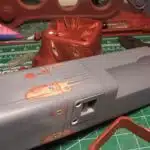







![How To Repair Rotted Wood 10 Texture : Altario Buick Estate Wagon : Rotting Faux Wood Paneling [1 of 2]](https://green-life.blog/wp-content/uploads/2023/05/z1CersK-gCjq-150x150.jpg.webp)


